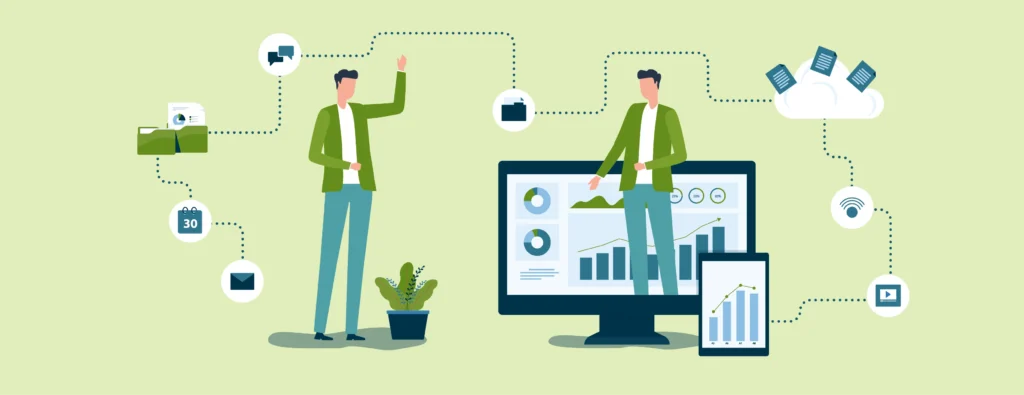
Humanizing Higher Ed Data: The Strategic Power of Student Digital Twins
Higher education institutions are overflowing with data, yet many still struggle to turn that information into actionable insight. With systems siloed across admissions, academics, student support, and alumni relations, it’s hard to get a clear picture of the student journey — let alone use that data to enhance engagement or predict outcomes.
Enter the “digital twin”: a transformative framework that helps institutions centralize, contextualize, and humanize student data. More than a dashboard or data warehouse, a student digital twin creates a living, dynamic model that reflects how students interact with your institution in real time. It’s the difference between looking at data and understanding a student.
The data disconnect holding higher ed back
Disconnected data is one of the most persistent obstacles facing colleges and universities. Key information is often trapped in different systems — student information systems (SIS), learning management systems (LMS), customer relationship management (CRM) tools, financial aid platforms, and more.
This fragmentation makes it difficult to:
- Personalize student communications
- Identify at-risk students in time to intervene
- Support seamless transfers or cross-departmental collaboration
- Harness emerging technologies like generative AI
The result? Missed opportunities, inefficient outreach, and limited visibility into student experiences.
Demystifying the student digital twin
A digital twin is a virtual representation of a physical entity. In higher education, that entity is the student. The student digital twin brings together behavioral, academic, and operational data to create a comprehensive, contextual profile of each learner.
Unlike a static dashboard or data warehouse, a digital twin captures relationships, sequences, and interactions. It enables institutions to:
- Visualize student journeys across systems
- Model future scenarios
- Generate predictive insights
- Power real-time personalization
Most importantly, a digital twin humanizes data by shifting the focus from systems to students.
What makes it work: The Connected Core® architecture
At Collegis, the digital twin is powered by Connected Core — a composable, cloud-native platform built specifically for higher education. The architecture includes:
- Integrated data fabric: A higher ed-specific data layer that unifies SIS, LMS, CRM, and more.
- Packaged business capabilities: Modular features like lead scoring, advising nudges, and financial aid workflows.
- Composable platform: A low-code development environment that allows institutions to customize workflows and experiences.
Together, these elements create an agile foundation for digital transformation and continuous improvement.
Ready for a Smarter Way Forward?
Higher ed is hard — but you don’t have to figure it out alone. We can help you transform challenges into opportunities.
Use cases that drive institutional impact
Digital twins aren’t theoretical. They’re already delivering measurable value across the student lifecycle. With real implementations across enrollment, student success, and digital engagement, Collegis partners are proving just how powerful a connected data foundation can be.
These examples show how the digital twin moves from concept to impact:
- AI lead prioritization: By integrating digital journey signals with CRM intelligence, one partner increased inquiry-to-appointment conversion by 38%.
- Transfer credit evaluation: AI-driven transcript assessments delivered >85% accuracy in early evaluations, reducing friction for prospective students.
- AI-powered website search: Semantic search functionality improved engagement by 250% during pilot testing, enhancing conversion potential.
These outcomes demonstrate how digital twins don’t just aggregate data — they activate it.
Implementation, integration, and ROI
One common question we encounter about this concept is, “Can’t we do this with our own data warehouse?” The answer is not really.
Data warehouses are optimized for reporting, not real-time personalization. The digital twin’s networked model is designed for operational use, enabling advisors, marketers, and faculty to act in the moment.
Collegis typically helps institutions realize value within three to six months. Whether starting with a marketing use case or building a full student model, we work with partners to:
- Identify quick wins
- Integrate priority data sources
- Build a data model tailored to their institution
Why Collegis — and why now?
Unlike generic analytics platforms, Connected Core is purpose-built for higher education. It’s not a retrofitted enterprise tool. The following features make it unique from other offerings:
- AI-native and human-centered: It’s designed to deliver explainable, actionable insights.
- Composed, not constrained: It’s flexible enough to integrate with legacy systems and custom-built tools.
- A strategic partnership: Collegis provides not just the technology, but the advisory services and data talent to ensure sustained success.
Start humanizing your student data
The digital twin helps institutions shift from reactive reporting to proactive engagement. It empowers colleges and universities to not only understand their students better, but to serve them more effectively.
Ready to explore how a student digital twin could transform your data strategy? Contact us to request a demo!
Innovation Starts Here
Higher ed is evolving — don’t get left behind. Explore how Collegis can help your institution thrive.
